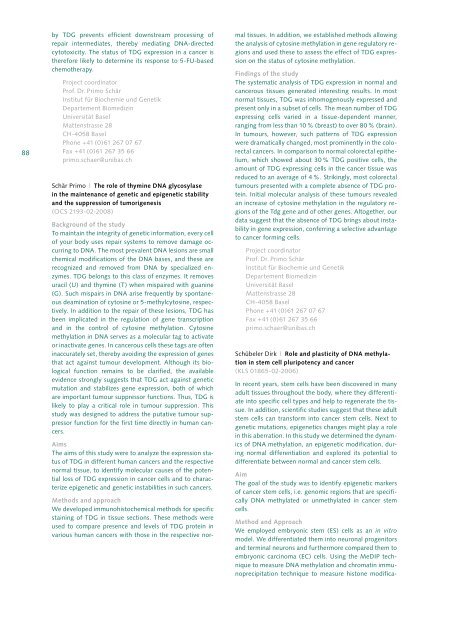Cancer Research in Switzerland - Krebsliga Schweiz
Cancer Research in Switzerland - Krebsliga Schweiz
Cancer Research in Switzerland - Krebsliga Schweiz
You also want an ePaper? Increase the reach of your titles
YUMPU automatically turns print PDFs into web optimized ePapers that Google loves.
88<br />
by TDG prevents efficient downstream process<strong>in</strong>g of<br />
repair <strong>in</strong>termediates, thereby mediat<strong>in</strong>g DNAdirected<br />
cytotoxicity. The status of TDG expression <strong>in</strong> a cancer is<br />
therefore likely to determ<strong>in</strong>e its response to 5FUbased<br />
chemotherapy.<br />
Project coord<strong>in</strong>ator<br />
Prof. Dr. Primo Schär<br />
Institut für Biochemie und Genetik<br />
Departement Biomediz<strong>in</strong><br />
Universität Basel<br />
Mattenstrasse 28<br />
CH4058 Basel<br />
Phone +41 (0)61 267 07 67<br />
Fax +41 (0)61 267 35 66<br />
primo.schaer@unibas.ch<br />
Schär Primo | The role of thym<strong>in</strong>e DNA glycosylase<br />
<strong>in</strong> the ma<strong>in</strong>tenance of genetic and epigenetic stability<br />
and the suppression of tumorigenesis<br />
(OCS 2193022008)<br />
Background of the study<br />
To ma<strong>in</strong>ta<strong>in</strong> the <strong>in</strong>tegrity of genetic <strong>in</strong>formation, every cell<br />
of your body uses repair systems to remove damage occurr<strong>in</strong>g<br />
to DNA. The most prevalent DNA lesions are small<br />
chemical modifications of the DNA bases, and these are<br />
recognized and removed from DNA by specialized enzymes.<br />
TDG belongs to this class of enzymes. It removes<br />
uracil (U) and thym<strong>in</strong>e (T) when mispaired with guan<strong>in</strong>e<br />
(G). Such mispairs <strong>in</strong> DNA arise frequently by spontaneous<br />
deam<strong>in</strong>ation of cytos<strong>in</strong>e or 5methylcytos<strong>in</strong>e, respectively.<br />
In addition to the repair of these lesions, TDG has<br />
been implicated <strong>in</strong> the regulation of gene transcription<br />
and <strong>in</strong> the control of cytos<strong>in</strong>e methylation. Cytos<strong>in</strong>e<br />
methylation <strong>in</strong> DNA serves as a molecular tag to activate<br />
or <strong>in</strong>activate genes. In cancerous cells these tags are often<br />
<strong>in</strong>accurately set, thereby avoid<strong>in</strong>g the expression of genes<br />
that act aga<strong>in</strong>st tumour development. Although its biological<br />
function rema<strong>in</strong>s to be clarified, the available<br />
evidence strongly suggests that TDG act aga<strong>in</strong>st genetic<br />
mutation and stabilizes gene expression, both of which<br />
are important tumour suppressor functions. Thus, TDG is<br />
likely to play a critical role <strong>in</strong> tumour suppression. This<br />
study was designed to address the putative tumour suppressor<br />
function for the first time directly <strong>in</strong> human cancers.<br />
Aims<br />
The aims of this study were to analyze the expression status<br />
of TDG <strong>in</strong> different human cancers and the respective<br />
normal tissue, to identify molecular causes of the potential<br />
loss of TDG expression <strong>in</strong> cancer cells and to characterize<br />
epigenetic and genetic <strong>in</strong>stabilities <strong>in</strong> such cancers.<br />
Methods and approach<br />
We developed immunohistochemical methods for specific<br />
sta<strong>in</strong><strong>in</strong>g of TDG <strong>in</strong> tissue sections. These methods were<br />
used to compare presence and levels of TDG prote<strong>in</strong> <strong>in</strong><br />
various human cancers with those <strong>in</strong> the respective nor<br />
mal tissues. In addition, we established methods allow<strong>in</strong>g<br />
the analysis of cytos<strong>in</strong>e methylation <strong>in</strong> gene regulatory regions<br />
and used these to assess the effect of TDG expression<br />
on the status of cytos<strong>in</strong>e methylation.<br />
F<strong>in</strong>d<strong>in</strong>gs of the study<br />
The systematic analysis of TDG expression <strong>in</strong> normal and<br />
cancerous tissues generated <strong>in</strong>terest<strong>in</strong>g results. In most<br />
normal tissues, TDG was <strong>in</strong>homogenously expressed and<br />
present only <strong>in</strong> a subset of cells. The mean number of TDG<br />
express<strong>in</strong>g cells varied <strong>in</strong> a tissuedependent manner,<br />
rang<strong>in</strong>g from less than 10 % (breast) to over 80 % (bra<strong>in</strong>).<br />
In tumours, however, such patterns of TDG expression<br />
were dramatically changed, most prom<strong>in</strong>ently <strong>in</strong> the colorectal<br />
cancers. In comparison to normal colorectal epithelium,<br />
which showed about 30 % TDG positive cells, the<br />
amount of TDG express<strong>in</strong>g cells <strong>in</strong> the cancer tissue was<br />
reduced to an average of 4 %. Strik<strong>in</strong>gly, most colorectal<br />
tumours presented with a complete absence of TDG prote<strong>in</strong>.<br />
Initial molecular analysis of these tumours revealed<br />
an <strong>in</strong>crease of cytos<strong>in</strong>e methylation <strong>in</strong> the regulatory regions<br />
of the Tdg gene and of other genes. Altogether, our<br />
data suggest that the absence of TDG br<strong>in</strong>gs about <strong>in</strong>stability<br />
<strong>in</strong> gene expression, conferr<strong>in</strong>g a selective advantage<br />
to cancer form<strong>in</strong>g cells.<br />
Project coord<strong>in</strong>ator<br />
Prof. Dr. Primo Schär<br />
Institut für Biochemie und Genetik<br />
Departement Biomediz<strong>in</strong><br />
Universität Basel<br />
Mattenstrasse 28<br />
CH4058 Basel<br />
Phone +41 (0)61 267 07 67<br />
Fax +41 (0)61 267 35 66<br />
primo.schaer@unibas.ch<br />
Schübeler Dirk | Role and plasticity of DNA methylation<br />
<strong>in</strong> stem cell pluripotency and cancer<br />
(KLS 01865022006)<br />
In recent years, stem cells have been discovered <strong>in</strong> many<br />
adult tissues throughout the body, where they differentiate<br />
<strong>in</strong>to specific cell types and help to regenerate the tissue.<br />
In addition, scientific studies suggest that these adult<br />
stem cells can transform <strong>in</strong>to cancer stem cells. Next to<br />
genetic mutations, epigenetics changes might play a role<br />
<strong>in</strong> this aberration. In this study we determ<strong>in</strong>ed the dynamics<br />
of DNA methylation, an epigenetic modification, dur<strong>in</strong>g<br />
normal differentiation and explored its potential to<br />
differentiate between normal and cancer stem cells.<br />
Aim<br />
The goal of the study was to identify epigenetic markers<br />
of cancer stem cells, i.e. genomic regions that are specifically<br />
DNA methylated or unmethylated <strong>in</strong> cancer stem<br />
cells.<br />
Method and Approach<br />
We employed embryonic stem (ES) cells as an <strong>in</strong> vitro<br />
model. We differentiated them <strong>in</strong>to neuronal progenitors<br />
and term<strong>in</strong>al neurons and furthermore compared them to<br />
embryonic carc<strong>in</strong>oma (EC) cells. Us<strong>in</strong>g the MeDIP technique<br />
to measure DNA methylation and chromat<strong>in</strong> immunoprecipitation<br />
technique to measure histone modifica

















